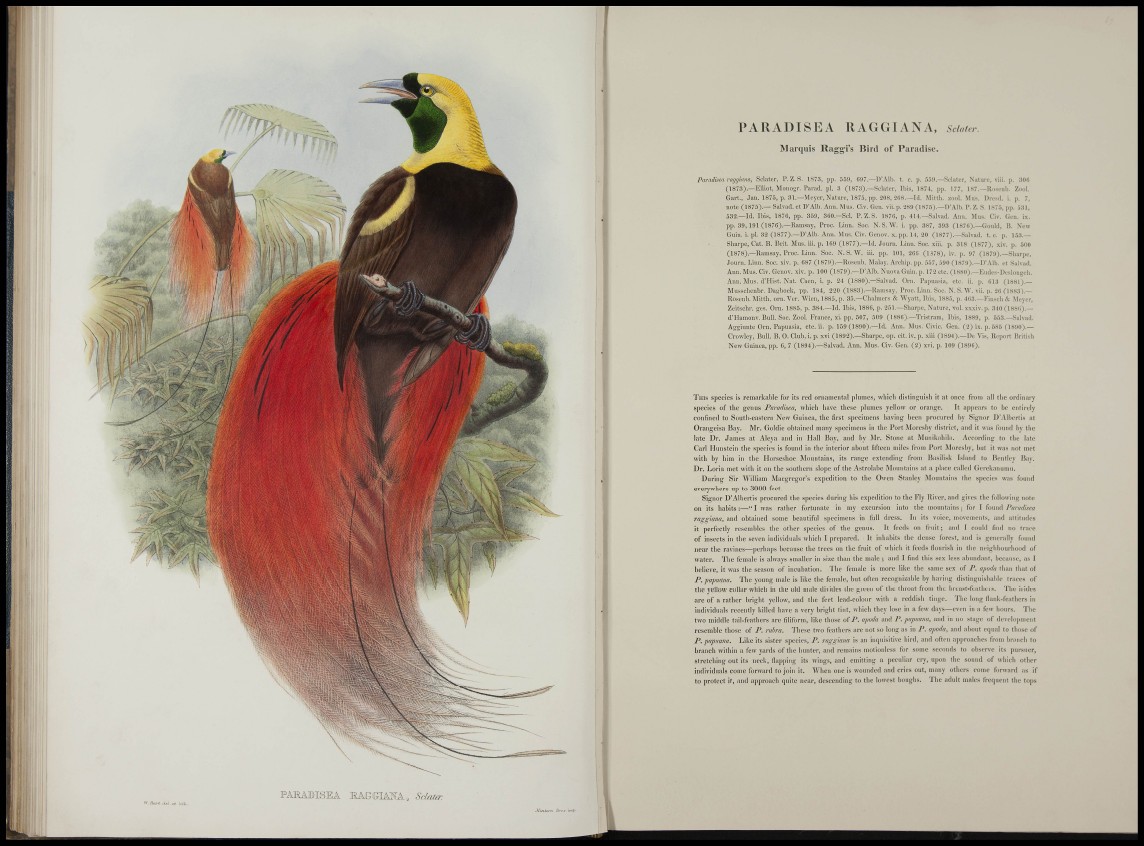
PARADISEA RAG Gì AN A, Schio-.
Marquis Raggi's Bird of Paradise.
Paradisca rmjgimw, Sclater, P. Z. S. 1873, pp. 559, 097.—I)'Alb. t. c. p. 55i).—ScUitcr, Nature, viii. p. :»)(!
(1873).—Elliot, Monogr. Parad, pi. 3 (1873).—Sclatcr, Ibis, 1874, pp. 177, 187.—Rusenb. Ziiol.
Gart., Jan. 1875, p. 31.—Meyer, Nature, 1875, pp. 20H,2(i8.—Id. Mitth. zool. Mus. Dresd. i. p. 7,
note (1875).— Salvad, et D'Alb. Ann. Mus. Civ. Gen. vii. p. 289 (1875),—IVAlb. P. Z. S. 1S75, pp. 531,
532.—Id. Ibis, 1876, pp. 359, 3(i0.—Scl. P. Z. S. 187(i, p. 4U.—Salvad. Ann. Mus. Civ. Gen. ix.
pp. 39, 191 (1876).—Ramsay, Pl-oc. Linn. Soe. N. S. W. i. pp. 387, 393 (1870).—Gould, B. New
Guin. i. pi. 32 (1877).—D'Alb. Ann. Mus. Civ. Genov. X. pp. 14, 20 (1877).—Salvad, t. c. p. 1,53.—
Sharpe, Cat. B. Brit. Mus. iii. p. 169 (1877).—Id. Journ. Linn. Soe. xiii. p. 318 (1877), xiv. ji. 500
(1878).—Ramsay, Proc. Linn. Soe. N. S. W. iii. pp. 101, 206 (1378), iv. p. 97 (1879).—Sharpe,
Journ. Linn. Soc. xiv. p. 087 (1879).—Roseub. Malay. Areliip. pp. 557, 590 (1879).—D'Alb. et Salvad.
Ann. Mus. Civ. Genov. xiv. p. 100 (1879).—D'Alb. NuovaGnin. p. 172 etc. (1880).—Eudes-Deslongeh.
Ann. Mus. d'Hist. Nat. Caen, i. p. 24 (1880).—Salvad. Orn. Papuasia, etc. ii. p. 013 (1881).—
Mnsschenbr. Dagboek, pp. 184, 220 (1883).—Ramsay, Proc. Linn. Soc. N. S. W. vii. p. 20 (1S83).—
Rosenb. Mitth. orn. Yer. Wien, 1885, p. 35.—Chalmers & Wyatt, Ibis, 1885, p. 463.—Finsch & Meyer,
Zeitsehr. ges. Orn. 1885, p. 384.—Id. Ibis, 1880, p. 251.—Sharpe, Nature, vol. xxxiv.p. .340(1880).—
d'llamonv. Bull. Soc. Zool. France, xi. pp. 507, 509 (1880).—Tristram, Ibis, 1889, p. 55.'!.—Salvad.
Aggiunte Orn. Papuasia, etc. ii. p. 159 (1890).—Id. Ann. Mus. Civic. Gen. (2) ix. p. 885 (1890).—
Crowley, Bull. B. O. Club, i. p. xvi (1892).—Sharpe, op. cit. iv. p. xiii (1894).—De Vis, Report British
New Guinea, pp. 0, 7 (1894).—Salvad. Ann. Mus. Civ. Gen. (2) xvi. p. 109 (1890).
THIS species lb remarkable for its red ornamental plumes, wliicli distinguish it at oncc from all the ordinary
species of the gCTUis Parad'tsea, which have these ¡dumes yellow or orange. It appears to he entirely
confined to South-eastern New Guinea, the first specimens havine^ been procured hy Signor D'Alhertis at
Orangeisa Bay. Mr. Goldie obtained many specimens in the Port Moresby district, arul it was found by tlie
late Dr. James at Aleya and in Hall Bay, and by Mr. Stone at Muiiikahihi. According to the late
Carl Hunstein the species is found in the interior about fifteen miles from Port Moresby, but it was not met
with by liim in the Horseshoe Mountains, its range extending from Basilisk Island to Bcntley Bay.
Dr. Loria met with it on the soutliern slope of the Astrolabe Mountains at a place called Gerekanumu.
During Sir William Macgregor's expedition to the Owen Stanley Mountains the species was found
everywhere up to 3000 feet.
Signor D'Alhertis procured the species during his expedition to the Fly River, and gives the following note
on its habits:—" I wiis rather fortunate in my excursion into the mountains; for I found/'mw/isea
ragguma, and obtained some beautiful specimens in full dress. In its voice, movements, and altitudes
it perfectly resembles the other species of the genus. It feeds on fruit; and I could find no trace
of insects in the seven individuals which I prepared. It inliabits the dense forest, and is generally found
near the ravines—perha])s because the trees on the fruit of whicli it feeds (lonrisli ii] the neiglibourhood of
water. The female is always smaller in size than the male ; and I find this sex less abundant, because, as I
believe, it was tlie season of incubation. The female is more like the same sex of P. apork than that of
P.papuana. The young male is like tlie female, but often recognizable by having distinguishable traces of
the yellow collar which in tlie old male divides the green of the lliroat from the breast-feathers. The irides
are of a rather bright yellow, and the feet lead-colour with a reddish tinge. The long fiank-feathers in
individuals recently killed have a very bright tint, which they lose in a few days—even in a few hours. The
two middle tall-feathers are filiform, like those of P. apoda and P.papuana, arid in no stage of development
resemble those of P. rubra. These two feathers are not so long as in P. apoda, and about equal to those of
P. papnam. Like its sister s])ecies, P. raggiam is an inquisitive bird, and often ajiproachcs from branch to
branch within a few yards of the hunter, and remains motionless for some seconds to observe its pursuer,
stretching out its neck, flap|)iiig its wings, and emitting a peculiar cry, upon the sound of which other
individuals come forward to join it. When one is wounded and cries out, many others come forward as if
to protect if, and approach quite near, descending to the lowest boughs. The adult males frequent the tops
flli/^ .W ei Liil,
PARADISEA liASGIASA,
.MinteJi, H'-i-." i">r